Filtering of EMG signals
DOI:
https://doi.org/10.7146/aripuc.v14i.131743Abstract
One of the ways to eliminate different kinds of disturbances in EMG signals is by filtering in the frequency domain. This procedure requires both a knowledge of the frequency content of the disturbing components and a knowledge of the frequency range of the relevant signal. Therefore, the frequency characteristics of an EMG material of various internal laryngeal muscles recorded by bipolar hooked-wire electrodes have been examined. We conclude that the highpass cutoff frequency normally proposed in the literature - i.e. 100 Hz or lower - is generally not sufficient to eliminate microphony and especially the movement artifacts. But the choice of filtering frequency will often be a compromise between the cutoff that is optimal with respect to removal of spurious components and the attenuation of the overall signal caused by the filtering. However, it is generally advisable to highpass filter the signal even at the expense of some overall attenuation, and the greatest improvement is often achieved by highpass filtering with cutoff frequencies well above the low range normally proposed.
Downloads
Published
How to Cite
Issue
Section
License
Copyright holder author

